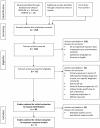Epidemiological evidence for work load as a risk factor for osteoarthritis of the hip: a systematic review
- PMID: 22348095
- PMCID: PMC3279372
- DOI: 10.1371/journal.pone.0031521
Epidemiological evidence for work load as a risk factor for osteoarthritis of the hip: a systematic review
Abstract
Objective: Osteoarthritis of the hip (OA) is a common degenerative disorder of the joint cartilage that presents a major public health problem worldwide. While intrinsic risk factors (e.g, body mass and morphology) have been identified, external risk factors are not well understood. In this systematic review, the evidence for workload as a risk factor for hip OA is summarized and used to derive recommendations for prevention and further research.
Methods: Epidemiological studies on workload or occupation and osteoarthritis of the hip were identified through database and bibliography searches. Using pre-defined quality criteria, 30 studies were selected for critical evaluation; six of these provided quantitative exposure data.
Results: Study results were too heterogeneous to develop pooled risk estimates by specific work activities. The weight of evidence favors a graded association between long-term exposure to heavy lifting and risk of hip OA. Long-term exposure to standing at work might also increase the risk of hip OA.
Conclusions: It is not possible to estimate a quantitative dose-response relationship between workload and hip OA using existing data, but there is enough evidence available to identify job-related heavy lifting and standing as hazards, and thus to begin developing recommendations for preventing hip OA by limiting the amount and duration of these activities. Future research to identify specific risk factors for work-related hip OA should focus on implementing rigorous study methods with quantitative exposure measures and objective diagnostic criteria.
Conflict of interest statement
Figures
Similar articles
-
A rapid and systematic review of the clinical effectiveness and cost-effectiveness of paclitaxel, docetaxel, gemcitabine and vinorelbine in non-small-cell lung cancer.Health Technol Assess. 2001;5(32):1-195. doi: 10.3310/hta5320. Health Technol Assess. 2001. PMID: 12065068
-
Exercise interventions and patient beliefs for people with hip, knee or hip and knee osteoarthritis: a mixed methods review.Cochrane Database Syst Rev. 2018 Apr 17;4(4):CD010842. doi: 10.1002/14651858.CD010842.pub2. Cochrane Database Syst Rev. 2018. PMID: 29664187 Free PMC article.
-
Home treatment for mental health problems: a systematic review.Health Technol Assess. 2001;5(15):1-139. doi: 10.3310/hta5150. Health Technol Assess. 2001. PMID: 11532236
-
OARSI recommendations for the management of hip and knee osteoarthritis, part I: critical appraisal of existing treatment guidelines and systematic review of current research evidence.Osteoarthritis Cartilage. 2007 Sep;15(9):981-1000. doi: 10.1016/j.joca.2007.06.014. Epub 2007 Aug 27. Osteoarthritis Cartilage. 2007. PMID: 17719803
-
WITHDRAWN: Non-aspirin, non-steroidal anti-inflammatory drugs for treating osteoarthritis of the knee.Cochrane Database Syst Rev. 2007 Jul 18;2006(1):CD000142. doi: 10.1002/14651858.CD000142.pub2. Cochrane Database Syst Rev. 2007. PMID: 17636601 Free PMC article.
Cited by
-
Reliability and validity of the Japanese version of the short questionnaire to assess health-enhancing physical activity (SQUASH) scale in older adults.J Phys Ther Sci. 2015 Feb;27(2):517-22. doi: 10.1589/jpts.27.517. Epub 2015 Feb 17. J Phys Ther Sci. 2015. PMID: 25729206 Free PMC article.
-
Subject-specific analysis of joint contact mechanics: application to the study of osteoarthritis and surgical planning.J Biomech Eng. 2013 Feb;135(2):021003. doi: 10.1115/1.4023386. J Biomech Eng. 2013. PMID: 23445048 Free PMC article. Review.
-
The prevalence of osteoarthritis: Higher risk after transfemoral amputation?-A database analysis with 1,569 amputees and matched controls.PLoS One. 2019 Jan 22;14(1):e0210868. doi: 10.1371/journal.pone.0210868. eCollection 2019. PLoS One. 2019. PMID: 30668582 Free PMC article.
-
An expert-based job exposure matrix for large scale epidemiologic studies of primary hip and knee osteoarthritis: the Lower Body JEM.BMC Musculoskelet Disord. 2014 Jun 13;15:204. doi: 10.1186/1471-2474-15-204. BMC Musculoskelet Disord. 2014. PMID: 24927760 Free PMC article.
-
Highlighting the Benefits of Rehabilitation Treatments in Hip Osteoarthritis.Medicina (Kaunas). 2022 Mar 30;58(4):494. doi: 10.3390/medicina58040494. Medicina (Kaunas). 2022. PMID: 35454333 Free PMC article.
References
-
- Sun Y, Brenner H, Sauerland S, Gunther KP, Puhl W, et al. Serum uric acid and patterns of radiographic osteoarthritis–the Ulm Osteoarthritis Study. Scand J Rheumatol. 2000;29:380–386. - PubMed
-
- Badley EM. The effect of osteoarthritis on disability and health care use in Canada. J Rheumatol. 1995;22:19–22. - PubMed
-
- Felson DT. Epidemiology of hip and knee osteoarthritis. Epidemiol Rev. 1988;10:1–28. - PubMed
-
- Sun Y, Sturmer T, Gunther KP, Brenner H. Incidence and prevalence of cox- and gonarthrosis in the general population. Z Orthop Ihre Grenzgeb. 1997;135:184–192. - PubMed
Publication types
MeSH terms
LinkOut - more resources
Full Text Sources


